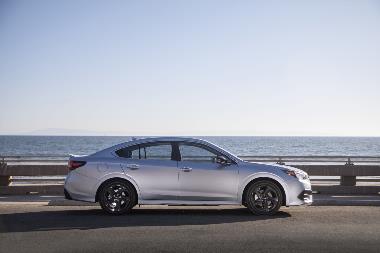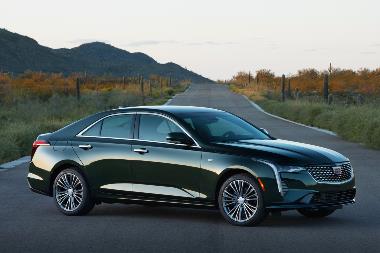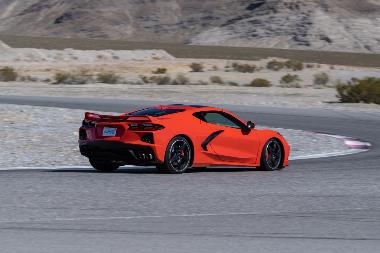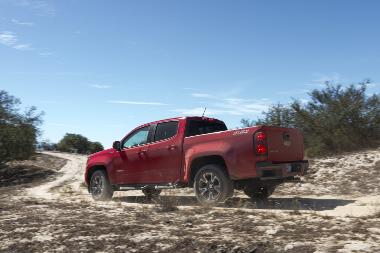-
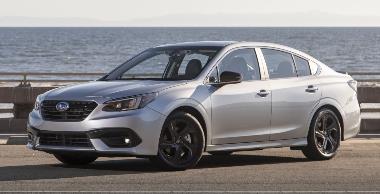
2020 Subaru Legacy: Redesigned with Added Sportiness, Power, Tech and Safety
Tuesday, Sep 1, 2020
Subaru launched the midsize Legacy badge in 1989, as a flagship that offered standard all-wheel-drive and a BOXER engine. Thirty years of successfu …
Show MoreSubaru launched the midsize Legacy badge in 1989, as a flagship that offered standard all-wheel-drive and a BOXER engine. Thirty years of successful sales later, Subaru of America introduced the all-new seventh-generation 2020 Legacy sedan – the most advanced Legacy in the model’s history. The 2020 Legacy presents with standard Subaru Symmetrical All-Wheel Drive and EyeSight® Driver Assist Technology, available tablet-style high-definition 11.6-inch SUBARU STARLINK™ multimedia screen, and DriverFocus™ Distraction Mitigation System. A 260-horsepower turbo engine powers up new XT models, and the redesigned sedan is equipped with new technology and safety features, and is based on a platform shared with Subaru’s high-rep Ascent and Forester.
The completely redesigned 2020 Subaru Legacy uptweaks with tech upgrades, turbo engine and new lane-centering add-on, and the platform that has been optimized for the midsize Legacy, boasting a structure that is 70-percent stiffer in both torsional and front-suspension rigidity and 100-percent stiffer in both front lateral flexural and rear subframe rigidity compared to the previous Legacy’s platform. Along with a strengthened suspension and lowered center of gravity, the Legacy’s improved body rigidity provides more responsive steering and handling, smoother and quieter ride, and heightened hazard avoidance in emergency situations. The 2020 Legacy comes with improved crash protection, as the new body absorbs over 40-percent more energy in front/side crashes than the previous model. When a crash is unavoidable, the Legacy protects with eight standard airbags, including a driver knee airbag.
In six trims, some with renewed sportiness, Legacy is still a family sedan, and is nearly 2 inches longer than Gen-Six, as other dimensions remain about the same. The 2020 Legacy is 15 to 50 pounds lighter than last year, and with the exception of 1.4 inches of greater rear legroom, interior accommodations are roughly the same as in 2019.
An aggressive stance and increased athleticism enhance Legacy’s exterior design, further augmented by its evolutionary grille shape, defined wheel arch, chrome accent at the rear pillars and squint-eye headlamps. The 5-passenger midsize sedan measures 190.6 inches long, 59.1 inches high and 72.4 inches wide on a 108.3-inch wheelbase, for a curb weight of 3499 lbs. for the base model and up to 3790 lbs. for uptweaked trims.
My Legacy Sport trim test ride was second up of the six trims, and boldly shows a performance-oriented exterior that features an exclusive rear bumper, front grille with high-gloss black bar, high-gloss black side mirrors, trunk lid spoiler and dark metallic 18-inch alloy wheels. Inside, the Sport comes with aluminum pedals as well as red stitching on the instrument panel, door trim, seats, shift lever boot and leather-wrapped steering wheel. The Sport cabin also upgrades with 10-way power adjustable driver's seat, analog instruments, Keyless Access with Push-Button Start and lots more.
For the first time since 2012, the Legacy lineup will feature a turbocharged engine. Standard on XT models, the 2.4-liter turbocharged BOXER engine delivers 260 horsepower and 277 lb-ft of torque, mated to a high-torque Lineartronic CVT with manual mode and steering wheel paddle control switches, and is rated at 24mpg/city and 32 mpg/highway. My Sport trim was a 2.5 model that powered up with a 2.5-liter DOHC Boxer engine that produces 182hp and 176 lb-ft of torque and is EPA rated at 27mpg/city and 35mpg/highway, though my tests yielded a lower average of 26.4mpg in mixed-use driving.
The turbo might launch a 0-60 mph sprint in an estimated 6.1 seconds, but my 2.5-liter BOXER sprinted in 7.9 seconds during a hand-timed 16.1-second quarter-mile. Slow and steady, the quick-ratio electric power-assisted rack and pinion steering was vague at high speed and in tight turns, but the suspension created a soft, gentle ride, limited body roll, and sightlines were unimpeded.
Subaru touts interior quietness -- 3 decibels quieter at highway speeds than Gen-Six – thanks to special door weather stripping and sound-insulating glass, and I did enjoy luxury-quiet in the cabin.
Inside, Legacy provides a cozy 39.4 inches of front headroom and 37.2 inches in row two – you lose two more inches up front with a sunroof. Legroom is 42.8 inches in row one and 39.5 inches in row two, and shoulder room comes in at 58.1 and 57.4.
Legacy safety is attended to well and the midsize earned a Top Safety Pick+ rating from the Insurance Institute for Highway Safety. Along with items mentioned above, Legacy safety technology includes standard Advanced Adaptive Cruise Control with Lane Centering. Additionally, Legacy has gained a rep for being long-lasting and dependable, with 96 percent of Legacy vehicles sold in the last 10 years still on the road today.
The 2020 Subaru Legacy starts at $22,745 for the base trim. The Legacy Premium trim starts at $24,995, the Legacy Sport starts at $26,945, the Legacy Limited starts at $29,745, the Legacy Limited XT with the 2.4 turbo starts at $34,195 and the Legacy Touring XT with the turbo starts at $35,895. My test Legacy Sport in Crystal White Pearl paint, added Blind Spot Detection with power moonroof, 11.6-inch touchscreen navigation and more for $2245, and moonroof air deflector added $99.99, Destination charges of $900 put the sticker-as-tested at $30,189.
> Visit www.CarlisleEvents.com for more on the automotive hobby.
Mike Blake, former editor of KIT CAR magazine, joined Carlisle Events as senior automotive journalist in 2004. He's been a "car guy" since the 1960s and has been writing professionally for about 30 years. </I>
-
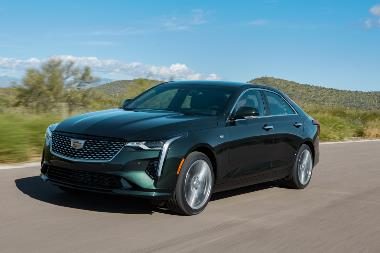
2020 Cadillac CT4: New Entry-Luxury Sedan Aimed at Younger Buyers
Tuesday, Aug 25, 2020
Cadillac dropped its compact executive 4-door (later, a two-door) sedan, ATS, after a seven-year run, in 2019. Taking over the compact luxury sports s …Cadillac dropped its compact executive 4-door (later, a two-door) sedan, ATS, after a seven-year run, in 2019. Taking over the compact luxury sports sedan spot in the Cadillac line-up is the all-new 2020 Cadillac CT4, which is marketed as an entry-luxury sports sedan to attract first-time luxury, and younger buyers to the Cadillac brand.Show More
Sharing its platform with the abandoned ATS, CT4 is its own design and personality, with two turbo engine choices, and up to 325 horsepower. Though that is quite a drop from ATS’s uppermost engine power choice of 464hp, CT4’s handling, performance and style are enough for it to earn its own rep, accolades and following.
CT4 enters the Cadillac sedan portfolio set to appeal to a new generation of sport-luxury customers through an immersive new social media campaign. Featuring a luxury-sports design, and bold 11-color color-and-trim palette, customers can customize to fit their personalities. Additionally, CT4’s sporty performance, RWD and AWD configurations, and high-technologies including Super Cruise -- the world’s first true hands-free driver assistance feature for more than 200,000 miles of compatible highways in the U.S. and Canada -- inject new ideas and function to the Cadillac line-up.
Available in four trims with specific cosmetic and power differences, CT4 offers special wheel options and is luxury loaded with leather-appointed seating, Automatic Emergency Braking, Forward Collision Alert, Front Pedestrian Braking, Safety Alert Seat and LED Reflective Windshield Collision Alert. Additionally, CT4 is outfitted with Cadillac User experience with Personalization and embedded Navigation, 8-inch-diagonal high-definition color-touchscreen driver information display, dual-microphone, Cloud3-based natural voice recognition, dual-display driver information center, 15-watt wireless charging and lots more.
The CT4’s sleek profile leverages the natural, long dash-to-front-axle proportional advantage of its rear-drive platform and, along with its wide stance, expresses presence, confidence and performance. Bright exterior accents, along with unique grilles (with premium hot foil-stampings on the grille elements) and fascias, distinguish the CT4 Luxury and Premium Luxury models. The Sport and V-Series models are differentiated by darker accents and performance-inspired details, including unique grilles, fascias, rocker extensions, rear spoiler and exclusive performance design wheels.
The sporty entry-luxury sedan measures 187.2 inches long, 71.5 inches wide and 56 inches high on a 109.3-inch wheelbase, weighing in at 3461 lbs. for the Luxury series in RWD, and 3616 for the V-Series in RWD.
CT4’s driver-focused and connected cabin is ergonomically optimized with intuitive controls to enhance driver confidence with a high-tech sense of tactility. Additionally, sophisticated use of metal accents throughout enhances the décor and technology-driven ambiance.
Inside, CT4 provides a surprisingly tight 38.3 inches of front headroom with only 36.5 inches for row two, 42.4 inches of front legroom with only 33.4 inches for back seaters and 55.2 inches of front shoulder room with 53.9 inches for row two.
Turbo power CT4 delivers power through two engine options. A 2.0-liter Twin-Scroll Turbocharged I-4 DOHC with Active Fuel Management, direct injection and auto stop/start, is mated to an eight-speed automatic with Electronic Precision Shift to provide 237hp and 259 lb-ft of torque. Option two is a 2.7-liter Dual-Volute Turbocharged I-4 DOHC with Active Fuel Management, direct injection and auto. stop/start. The CT4's dual-volute turbo (a volute is a spiral-shaped object) and ten-speed automatic transmission with Electronic Precision Shift provides 310hp and 327 lb-ft, and is augmented for the CT4-V Series to supply 350hp and 380 lb-ft.
My 310-hp 2.7-liter plant was rated at 23mpg/city and 32mpg/highway with 4WD, and I averaged 25.5mpg during my heavy-footed tests. Around town, the ride was smooth, maneuverable and attentive in turns and acceleration. On the highway, passing was effortless, road inadequacies were leveled out, and on curves and the autocross, CT4 was nimble, responsive and powerful. In track tests, my test ride finished off a hand-timed zero-to-60mph sprint in 5.1 seconds, though sub-4s can be achieved, and my quarter-mile was a steady 13.6 seconds (hand-timed).
The 2020 Cadillac CT4 is available in four trims, in either Rear-Wheel-Drive or All-Wheel-Drive configurations and with two engine choices. The base Luxury trim starts at $33,990 (including Destination charges) in RWD – only available with a 2.0-liter turbo engine; Premium Luxury starts at $38,490 in the 2.0-liter turbo and $40,990 with the 2.7-liter turbo; Sport starts at $39,590 with the 2.0-turbo; and the V-Series, comes with the 2.7-liter turbo, starting at $45,490.
My 2020 CT4-Premium Luxury was the 2.7-liter model and added AWD for $3200 (sticker started at $44,190). Evergreen Metallic exterior paint added $625, and was accented by a Jet Black interior with Jet Black accents, Leather-appointed seating with mini-perforated inserts; Navigation and 14-speaker Bose Premium audio added $1700; Climate Package added $1200 for automatic heated steering wheel and 4-way power driver and front passenger lumbar and heated / ventilated seats; Driver Assist added $1200 for Advanced Adaptive Cruise Control, Enhanced Automatic Emergency Braking and Reverse Automatic Braking; Technology Package added an 8-inch diagonal color reconfigurable gauge cluster, Head-Up Display and Cabin Air Ionize for $1150; and the Driver Awareness Plus Package added Following Distance Indicator, Lane Change Alert with Side Blind Zone Alert, Lane Keep Assist with Lane Departure Warning, Rear Cross Traffic Alert and IntelliBeam auto high beam assist for $800. Destination charges were $995, for a sticker-as-tested of $49,665 – with some bundling discounts.
> Visit www.CarlisleEvents.com for more on the automotive hobby.
Mike Blake, former editor of KIT CAR magazine, joined Carlisle Events as senior automotive journalist in 2004. He's been a "car guy" since the 1960s and has been writing professionally for about 30 years. </I>
-
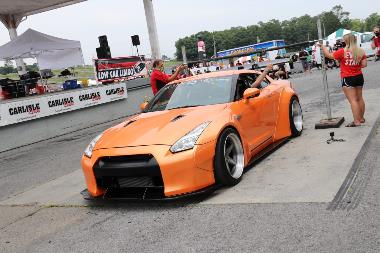
Driven to Cure...and Entertain!
Wednesday, Aug 19, 2020
In late spring, the team with Carlisle Events made the difficult decision to postpone the Carlisle Import & Performance Nationals from its orig …
Show MoreIn late spring, the team with Carlisle Events made the difficult decision to postpone the Carlisle Import & Performance Nationals from its original May dates to the second weekend of August. As world events evolved, August 14 through the 16th rapidly approached and with the weekend in the rearview mirror, it was obvious that while the date change would slightly augment the show, the passion and enthusiasm of those who attended would not be altered. Spanning the three-day event, over 1,000 cars and even more attendees walked the grounds, enjoyed great concessions, participated in competitions and otherwise just hung out and enjoyed the automotive world at the Carlisle PA Fairgrounds.
Gates opened Friday at 7 a.m. and while most guests didn’t arrive until mid-day, waiting for them was a great indoor display in Building T. Here, the BBS was celebrated as was 100 Years of Mazda and 50 Years of the Datsun and Nissan Z. There was also a general vehicle display too, including a Lamborghini, C8 Corvette and an ‘80s era Ferrari. Along with those displays indoors, the outside offered even more history with a massive SAAB tent, a Showfield of Audi’s, Volvo’s and more.
The Showfield itself is really the draw, as it offered such an eclectic mix of automotive history. Cars represent over a half a dozen countries and are parked by country of origin. The geographical placement allows guests to walk the grounds and essentially the automotive world. One of the countries, France, historically sees support from the Renault Club. For 2020, they had some early 20th century French production on display, while more modern rides also made up this international automotive festival. Dune Buggies cruised the grounds, the Opel saw lots of love as did displays with Fiat, Subaru, BMW and VW just to name a few.
Of course the cars at Carlisle didn’t just show, many were on the go via multiple competitions and or/a parade. These competitions included a couple of preliminary rounds for the rolling exhaust contest, the exhaust finale itself, drift limbo, low car limbo and of course the ultimate competition, the judged Showfield. There was even a mid-day Saturday parade as the Nissan Z went from being featured to in motion as part of an impromptu parade around the grounds.
Car clubs were also a big part of the event, dozens of clubs set up shop at Carlisle, and select clubs won awards as well. Saabs at Carlisle was tapped as the largest club, while Street Distortionz earned coolest club honors.
Hundreds of awards were doled out Sunday following another successful eJudged event, with car owners making plans for the 2021 event. Speaking of which, with less than nine months to go, plans are under way for the weekend, back to its original May dates; in this case May 14-16 2021. Check out photos and more about the event at www.CarlisleEvents.com.
-
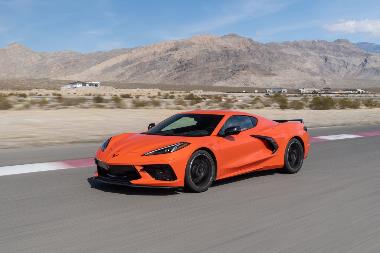
2020 Corvette Stingray: Re-imagined with a mid-engine setup and 490hp
Tuesday, Aug 18, 2020
The original second-generation C2 Corvette Sting Ray (1963-1967) rocketed into America’s consciousness with a powerful group …
Show MoreThe original second-generation C2 Corvette Sting Ray (1963-1967) rocketed into America’s consciousness with a powerful group of engines that ranged from 327 cubic inches to 427 ci. and galloped as many as 435 horses. Corvette’s Generation-3, or C3, shortened the marque to one word, “Stringray” (1968-1982) and was powered by engines ranging from 305 ci. to 454 ci. engines with ranges of muscle from an un-Vettelike 270 horses to a more appropriate 450 hp.
Brought back in 2014, and capturing a carload of awards for performance and appearance, while winning “Best-in-Class” honors, the Corvette Stingray continues to move forward with exterior, connectivity and technology enhancements that offer customers more personalization choices and convenience features. For 2020, the C8 (eighth-generation) Corvette sees a brand new, re-imagined Stingray with the brand’s first-ever production mid-engine Corvette and new levels of performance, tech advances, craftsmanship and luxury. Corvette’s marketing department heralds the new Stingray as a sports car that “… looks and feels like a Corvette, but drives better than any vehicle in Corvette history.” And in terms of the Corvette power legacy, its 490 horses eclipses the original by a herd of thoroughbreds.
Built at GM’s Bowling Green, Kentucky, assembly plant, the 2020 Corvette Stingray is longer, wider and a few pounds heavier, with the same aerodynamic height and with nearly the identical cockpit accommodations as the previous generation. The new mid-engine layout gives the 2020 Stingray better weight distribution, with the rear weight bias enhancing performance in a straight line and on the track and better driver control with driver positioning closer to the front axle, almost on top of the front wheels.
Stingray’s design, inspired by racing and aeronautics, employs a bold, futuristic expression with mid-engine exotic proportions that still evokes Corvette. The 2020 Stingray is enhanced by low profile headlamps designed around all-new projectors; completely hidden door, hood and hatch releases that do not disrupt the sculpted design; large side air intakes for engine cooling and aerodynamic performance; and a canopy-forward stance that was inspired by F22s, F35s, other modern fighter jets and by Formula One racing.
The new 2020 Stingray Coupe gains 5.4 inches in length, 2.2 inches in width and 0.5 inches in wheelbase, with the same height as last year, and now measures 182.3 inches long, 76.1 inches wide and an aerodynamic road-hugging low 48.6 inches high on a 107.2-inch wheelbase. Stingray weighs in with a curbweight of 3366 lbs., though with a full set of options, you could top out at 3650 lbs.
The 2020 Stingray’s cockpit is driver-oriented with passenger comfort, augmented by premium interior materials executed at a high level of quality and craftsmanship. Hand-wrapped, cut-and-sew leather components with thick press stitching and generous use of real metal highlight the environment. The jet fighter-inspired wraparound cockpit is cozy with good sightlines and tech and comfort go hand-in-hand with intuitiveness. Corvette Stingray’s interior combines luxury with a sports car feel, and packed with tech and comfort amenities with seating for two, Stingray provides 37.9 inches of headroom, an accommodating 42.8 inches of legroom and 54.4 inches of shoulder room in luxurious seats. New technology features include Corvette’s next-generation high-res infotainment system; Learn-as-you-go voice recognition; improved real-time traffic; a new 12-inch customizable instrument cluster tailored to all six driver modes; heated steering wheel; premium audio systems and the most personalization options ever for Corvette.
Talking power, the first production mid-engine in Corvette history runs with a small-block 6.2-liter LT2 V8 rated at 490 horsepower and 465 lb-ft of torque. When equipped with the Z51 performance package, maximum horsepower bumps up to 495 and peak torque to 470 lb-ft. Chevrolet says the Z51 will do sub-3.0-second zero-to-60 dashes, and my test 490-hp setup still smoked the sprint in 3.1 seconds during an 11.4-second hand-timed quarter-mile.
Response is rocketlike and steering is attentive with enough predictable understeer to be autocross entertaining. Racecar tight and road hugging, Stingray is fun, highway worthy, in-town maneuverable, versatile and exciting. You can set the exhaust note to quiet mode, but, the exhaust growl is part of the Corvette personality to me sooooo growl away.
The setup is EPA rated at 16mpg/city and 27mpg/highway and I averaged 18.6 mpg through in town errands, highway cruises and lots of tire smoking.
The 2020 Corvette Stingray Coupe bases at $59,995 for the 1LT trim and the Convertible stickers at $67,495. Three Coupe trim levels will take you up to $71,945 for the heavily uptweaked 3LT. More than 50 percent of Corvettes sold are 1LT trims, so my test vehicle started with that. Sebring Orange Tintcoat exterior paint added $995 and was striking against Jet Black Performance Textile interior with Jet Black Leather seats. For $5000 the Z51 Performance package and its 5 extra hp, and performance spoiler, front splitter, exhaust, brakes, suspension, rear axle, tires and slip-differential is popular, but we went without it. Lots of cosmetics, decals and exterior and interior enhancements are available, but my test ride passed on them. Inside, we opted up with the Chevrolet Infotainment 3 Premium System with Navigation and 8-inch diagonal HD color touchscreen for $1795. Destination freight charges of $1095 put the sticker-as-tested at $60,990, which seemed low for this new legend.
You can see the 2020 Corvette Stingray and more than 5,000 Corvettes that cross the 67-year history of America’s sports car, at the world’s largest Corvette event in the world – 2020 Corvettes at Carlisle, August 27-30 at the Carlisle (PA) Fairgrounds. The event represents all generations of “America’s Classic Sports Car,” and includes burnouts, autocross competition, a huge swap meet and a parade and street party in downtown Carlisle. And there are fun events lined up for the entire family.
> Visit www.CarlisleEvents.com for more on the automotive hobby.
Mike Blake, former editor of KIT CAR magazine, joined Carlisle Events as senior automotive journalist in 2004. He's been a "car guy" since the 1960s and has been writing professionally for about 30 years. </I>
-
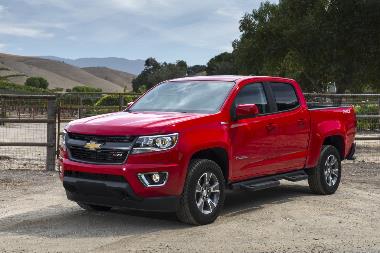
2020 Chevrolet Colorado: Mid-size Pickup Combines Nimbleness and Maneuverability
Tuesday, Aug 11, 2020
Beginning in the mid-to-late 1990s, the mid-size pick-up truck segment seemed to have lost its spirit and public appeal. However, in the early 2000s, …Beginning in the mid-to-late 1990s, the mid-size pick-up truck segment seemed to have lost its spirit and public appeal. However, in the early 2000s, the segment revitalized as consumers began thinking that smaller might be better at times, so Chevrolet took notice and returned to the small-package pick-up genre in 2004 with the Colorado, a compact pick-up launched to replace the Chevy S-10, in tandem with the GMC Canyon, which replaced the GMC S-15.Show More
Thinking outside the truck box for Colorado’s second generation in 2012, Chevrolet resisted the impulse to build a “baby Silverado” by developing Colorado-specific architecture with a spirited demeanor. Colorado’s design is unique with a confident stance, aggressiveness, tall bedsides, a bold raked belt line for the cab, wrap-around headlights, distinctive trapezoid grille and more subtle fender flares. And the exciting ZR-2 and ZR-2 Bison come with a widened stance, higher suspension and enhanced off-road capabilities. Chevrolet also recognized that in trucks, power takes precedence, and to address that, Colorado, which began with 116-hp and 142-hp engines (206-to 216-lb-ft of torque) in 2004, has steadily increased its muscle to as much as 308 horses on one engine option and up to 369 lb-ft of torque on another.
Next year, Colorado will refresh with an updated grille, and a third generation should hit the showrooms in 2023 or 2024. So the second-Gen Colorado for 2020 adds only a key fob-operated tailgate lock control, a Tire Fill Alert, and Package-level changes including the Safety Package now available for the Z71 trim, changing the Chrome Luxury package to the Luxury Package, now available on Crew Cab models, and deletion of several cab long bed models, as well as the Redline and RST Luxury Special Packages.
With a Crew Cab and 5-foot-2-inch box (it is also offered with a 6-foot-2-inch box and can be optioned with an Extended Cab), the 2020 Chevrolet Colorado measures 212.7 inches in length, 70.6 inches high (in 4WD) and 74.3 inches wide on a 128.3-inch wheelbase (the larger box requires 224.9 inches in length on a 140.5-inch wheelbase). Step-in height is 22.6 inches and minimum ground clearance is 8.2 inches. Curb weight for my LT trim came in at 4433 lbs. for the 3.6-liter engine, short box and Crew Cab in 4WD – the long box adds about 63 lbs. The Colorado features triple-sealed doors inlaid in the body sides and offers the segment’s first active aero grille shutters, designed to enhance aerodynamics when closed.
The interior is packed with convenience and safety features that blend attention to the driver’s need for work, recreation and everyday comfort. A bold, upright instrument panel with large controls and a center console with a floor-mounted shifter are a center focus, and a sculpted headliner that enhances headroom. Halo lighting on key controls offer an easier view and an open area at the front of the center console for easier phone charging are upscale appointments for a smaller truck.
Inside, with the Crew Cab, driver and passengers get 41.4 inches of front headroom and 38.3 in the Crew extension, 45.1 inches of front legroom with 35.8 for those in the second row, and shoulder room of 57.5 inches in row one and 56.2 in row two.
Engine choices are a 2.5-liter DOHC I-4 engine that puts out 200 hp and 191 lb-ft. of torque and is EPA rated at 19mpg/city and 24mpg/highway for the 4WD version, while the 3.6-liter V-6 delivers 308 hp and 275 lb-ft. of torque with an EPA estimate of 17/24 for 4WD. The 2.8-liter turbodiesel that hums out 181 hp and a strong 369 lb-ft is rated at 19/28. My mixed-use tests put the 3.6-liter’s average at 21.1 mpg.
Nimble and maneuverable, utilizing its wide mid-size stance and demeanor, my Colorado LT’s electric power-assisted rack-and-pinion steering was responsive, and its maneuverability was markedly better than that of a full-size truck, but not carlike. I found only minimal bed looseness as my test truck attacked turns with confidence. Acceleration was steady and predictable in all ranges, and at the track, my LT 3.6 completed a hand-timed zero-to-60mph sprint in 7.1 seconds, and a quarter-mile in 15.5 (hand-timed). My LT’s 4-wheel-drive independent coil-over-shock front suspension with twin-tube shocks, mated to a solid axle rear with semi-elliptic two-stage multi-leaf springs and twin-tube shocks smoothed most road inconsistencies and was adequate for soft-road, and non-extreme off-road challenges.
The 2020 Chevrolet Colorado starts at $27,895 for the base WT trim in 2WD with the 2.5-liter engine, $30,895 for the LT in 2WD with the 2.5-liter engine, $35,095 for the Z71 trim and 3.6-liter, $44,195 for the base ZR-2. My test LT in 4WD started at $35,595 and upgraded to the 3.6-liter powerplant. Red Hot exterior paint was no extra charge, and a Luxury Package that added Jet Black, Leather-appointed seat trim, 4-way power front passenger seats, power driver seat lumbar control, the LT Convenience package, projector-beam headlamps, heated driver and front passenger seats, automatic climate control, remote start, manual sliding rear window, heated steering wheel, rear window defogger, fog lamps and more, added $2715. Front and rear splash guards added $180, Navigation added $495, 7-speaker Bose audio system was $500, The Safety Package for $690 added Forward Collision Alert and Lane Departure Warning, and destination and freight added $1195 for a sticker-as-tested of $40,175.
> Visit www.CarlisleEvents.com for more on the automotive hobby.
Mike Blake, former editor of KIT CAR magazine, joined Carlisle Events as senior automotive journalist in 2004. He's been a "car guy" since the 1960s and has been writing professionally for about 30 years. </I>
Book with a preferred Hotel

Book online or call (800) 216-1876
